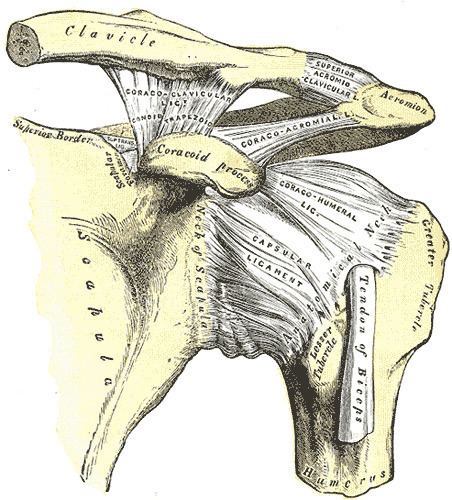From glenoid cavity TA A03.5.08.003 | FMA 34961 | |
 | ||
Latin ligamenta glenohumeralia | ||
In human anatomy, the glenohumeral ligaments (GHL) are three ligaments on the anterior side of the glenohumeral joint (i.e. between the glenoid cavity of the scapula and the head of the humerus; colloquially called the shoulder joint). Reinforcing the anterior glenohumeral joint capsule, the superior, middle, and inferior glenohumeral ligaments play different roles in the stability of the head of the humerus depending on arm position and degree of rotation.
Contents
Location
The ligaments may be best seen by opening the capsule at the back of the joint and removing the head of the humerus:
In addition to these, the capsule is strengthened in front by two bands derived from the tendons of the Pectoralis major and Teres major respectively.
Function
During abduction of the arm the middle and inferior ligaments become taut while the superior ligament relaxes. The radius of curvature of the head of the humerus is greater superiorly than inferiorly, which further stretches these ligaments so that they keep the articular surfaces of the joint in their close-packed position.
During abduction the greater tubercle of the humerus comes in contact with the upper margin of the glenoid cavity, which limits maximum abduction. By rotating the humerus laterally, this contact is delayed because the greater tubercle is pulled back so that the bicipital groove faces the coracoacromial ligament. This slightly slackens the inferior fibres of the glenohumeral ligament, allowing an abduction of 90°. Combining abduction with 30° flexion in the plane of the scapula causes a delay in the tightening of the ligament resulting in a maximum abduction of 110°.
During rotation of the arm lateral rotation stretches all three ligaments while medial rotation relaxes them.
